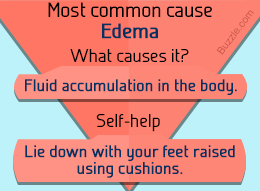Swollen feet and ankles is a common problem faced by many elderly people. It is a symptom associated with several underlying health disorders. This article will provide you with some relevant information on this ailment.

Inflammation in the lower parts of the legs could be a painful condition, but there are times when one does not experience any pain. Swollen ankles are quite common in the elderly. Sometimes, the swelling may get extended up to the calves and thighs as well. It may or may not occur on both the legs. Elderly people mostly get it after standing for a long time or when traveling by flight or vehicle for long hours. Usually, this is normal and harmless.
Causes
There are many causes of ankle swelling in elderly. As blood gets accumulated in the feet under the effect of gravity, swelling occurs. It subsides as soon as they move on their feet. However, recurrent swelling of the ankles should not be ignored as it could be a symptom of a more serious issue. To get rid of this problem, it is important to understand the underlying medical condition. Some of the main and common causes are explained here:
Edema: This is a condition of bad circulation in the body which leads to accumulation of fluid under the skin. With the increase in age, the veins stop functioning normally. As a result, fluids get trapped into the intracellular spaces. Sometimes, fluid accumulation in the legs is considered as an early sign of kidney failure, heart failure or liver failure.
Gout: Our body produces uric acid at the time of digestion of food which is thrown out of the system through the kidneys. However, if there is an excess amount of uric acid in the blood, the body cannot expel it completely and it gets accumulated in crystal forms in the feet. This condition is known as gout and its key symptoms are pain and inflammation of the ankles.
Arthritis: Due to aging, degeneration of the ankle joints is natural and this causes ankle arthritis which can be identified with pain and swelling in the area. Those patients who have a medical history of rheumatoid arthritis are prone to this inflammatory disease. It can also develop because of some old ankle injury.
Vascular Obstruction: This results from obstruction in the normal flow of blood mostly due to formation of blood clots. As a result, the ankle swells up and the swelling may even spread to the feet and up the leg as well. The effects of vascular obstruction can be found only in one leg and not both.
Ankle Injury: This can happen due to sprain or stress fracture in the ankle. As we grow old, the bones become fragile and even a light sprain can cause fracture in the ankle bones and lead to swelling. Stress fracture is more commonly observed in those who are obese as too much of pressure is exerted on the ankles by the excessive body weight.
Prevention
- Elderly people should not sit or stand in one place for a long time. They should take a brief walk as often as possible.
- While sitting or lying down, they should always try to keep their legs at an elevated position. When they sleep, they should put one or two pillows below their feet to position them above the level of the heart.
- Support stockings are available in medical stores which give a lot of relief to swollen feet and ankles.
- Fluid retention in the body can be checked to some extent by restricting the intake of sodium. In certain cases, massaging of the ankles with long upward strokes has proved to be highly beneficial.
- Hot and cold compression of the ankles in alternate manner are effective to reduce the pain and swelling of ankle joint.
- Mild leg stretching exercises improve the strength and flexibility of the arthritis-affected ankle joint and thus the inflammation is brought down.
- Those who are overweight should lose some weight to minimize the pressure from the ankles.
When there is a mild swelling in the ankles in elderly, then these measures taken at home can help to bring down the inflammation. However, if it persists for a long time and the home treatments fail to show desired results, then doctor should be consulted who will diagnose the underlying cause and treat the patient accordingly.
Disclaimer: This Buzzle article is for informative purposes only, and should not be used as a replacement for expert medical advice.


 Inflammation in the lower parts of the legs could be a painful condition, but there are times when one does not experience any pain. Swollen ankles are quite common in the elderly. Sometimes, the swelling may get extended up to the calves and thighs as well. It may or may not occur on both the legs. Elderly people mostly get it after standing for a long time or when traveling by flight or vehicle for long hours. Usually, this is normal and harmless.
Inflammation in the lower parts of the legs could be a painful condition, but there are times when one does not experience any pain. Swollen ankles are quite common in the elderly. Sometimes, the swelling may get extended up to the calves and thighs as well. It may or may not occur on both the legs. Elderly people mostly get it after standing for a long time or when traveling by flight or vehicle for long hours. Usually, this is normal and harmless.